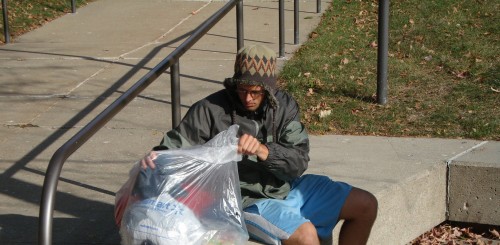
Tim Wilson '12 carried a garbage bag with all his possessions for the week of the homeless simulation.
College kids eat strange things. And they dress pretty sloppy too. At least that’s what adults often think. But last week, a group of students on Central’s campus was dressing and eating much worse than usual. Their clothes were noticeably dirty. They salvaged donuts from the trash and shared a cold chicken pot pie, scooping it up with Cheez-its. Several people split one small Panini from Grand Central Station.
The students behaved like they had nothing to eat and nowhere to stay. Fortunately, they were only pretending—as part of a homeless simulation sponsored by Campus Ministries. From Oct. 23-28, 16 students gave up their dorm rooms to find out what being homeless was really like.
“The purpose was to empathize with people who are homeless and, out of that, to find ways we can reach out to that population,” says Nick Rohner, worship/ministry team coordinator, who organized the simulation. “Students know that homelessness affects a large number of people. It’s just difficult to relate to because the majority of Central students come from middle class or upper middle class families.”
In order to be as authentic as possible, the participants followed strict rules. They carried all their items in a garbage bag—an extra set of clothes, a sleeping bag or blanket, toothpaste, toothbrush, deodorant and one book besides the Bible. Soap and shampoo were not allowed; neither was food. Participants were not supposed to go to their dorms except to switch books. They did homework on public computers and avoided using cell phones except in case of emergency.
For most students in the simulation, sleep was the hardest part. The first night, the group slept outside, in a grove of trees near Weller Center. Britt Cooper, a senior interdisciplinary major, says it was “ridiculously cold.” Some in the group didn’t sleep at all. They spent one more mild night outside, in West Market Park, before moving inside the rest of the week—sleeping on floors in Maytag, Graham Conference Center and the Chapel.
Another tough aspect of the simulation was the quality of the meals. Participants weren’t allowed to ask for food; they had to wait for people to offer it. Many students were generous, but the gifts were often high-carb snacks like cookies and chips, which don’t provide much long-lasting energy.
Generosity and compassion were regular reactions from students on campus. A few even said they had trouble sleeping in their warm dorm rooms because they were thinking about the group sleeping outside. “That really struck me deep,” says Tim Wilson, a senior math and computer science major.
Still, there were some cynical reactions from students who didn’t understand the group’s motives. “If somebody was actually homeless on campus, would it be that easy for people to turn their heads?” asks Rohner. “That question was wracking a lot of us by the end of the week.”

Although reactions to the simulation were mixed, the participants learned an important and unexpected lesson: the importance of community. With no ability to watch TV or waste time on the Internet, the students finished their homework early and spent the evenings together playing cards and talking. Whatever food they were given or found they split among the group. “It’s hard not to get close when you’re spoon-feeding someone from the garbage,” says Cooper.
Despite the hardships, the participants insist the simulation was not even close to being authentic. People on campus knew them; community members could see they were nice kids. So the food was easy to come by. And on tough nights, there was always the option of going back to the dorms if things got too bad. That’s why Campus Ministries is considering another simulation next year on a different college campus, where no one would recognize them and homelessness is a more common problem.
The simulation got people on campus, particularly the participants, thinking about homelessness in a city where it doesn’t exist. When sifting through the garbage of a local restaurant, Wilson was repulsed by the refuse he saw. But he couldn’t help thinking: “How long would it take for me to be hungry enough to eat that?”
Cooper spent the week thinking about the best way to help the homeless. “Now I understand where people are coming from when they’re actually begging on the street,” she says. “But I’m wondering if handouts are the best way. I feel like it’s just putting a Band-Aid on something instead of solving the problem.” She has resolved to do more research on strategies to combat homelessness. And in a few weeks, many of the participants are traveling to Ottumwa to help serve food at a shelter.
The simulation was an opportunity to reflect on a complicated social issue, but it also led students to personal transformations. “I learned to appreciate the simple things,” Cooper says. “It’s cliché but true.”
